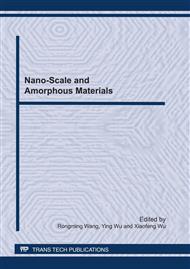p.301
p.307
p.314
p.321
p.326
p.334
p.339
p.344
p.349
Synthesis, Characterization and Capacitive Behaviors of Nanoporous Carbons Obtained by Using the Template of Zeolite-13X/MCM-48 Biporous Molecular Sieve
Abstract:
Zeolite-13X/MCM-48 biporous molecular sieve has been synthesized in the mode of overgrowth of MCM-48 on the surface of pre-added zeolite 13X. This kind of biporous molecular sieve has been taken as the template to prepare nanoporous carbons by a two-step casting process with furfuryl alcohol and acetonitrile as the precursors. The structures and textures are characterized by X-ray diffraction, nitrogen sorption at 77 K and high-resolution transmission electron microcopy. The electrochemical performances of the as-prepared porous carbons were tested by cyclic voltammetry and galvanostatic charge-discharge cycling in aqueous electrolyte. One of the carbon samples (labeled as C3-3) which is prepared by adding 5% zeolite-13X in the MCM-48 sol as the template and conducting acetonitrile chemical vapor deposition for 4 h after the impregnation of furfuryl alcohol. The C3-3 nanoporous carbon keeps the structure ordering and has the capacitance of 197 F g-1 at 2 mV s-1. The cycling performance of this carbon sample is excellent, which can maintain above 90% capacitance after 1000 cycles at 1 A g-1.
Info:
Periodical:
Pages:
326-333
Citation:
Online since:
June 2011
Authors:
Price:
Сopyright:
© 2011 Trans Tech Publications Ltd. All Rights Reserved
Share:
Citation:


